It was the end of my time in Europe, as I was set to fly out of Cologne in a few days. I had just traveled from Strasbourg, France to a friend’s house just outside of Mannheim, Germany, and I was trying to figure out the best way to Cologne from there.
“If you take the train from Mainz, I can show you the Isis temple in the basement of the mini-mall,” she said to me.
I was sure that I hadn’t heard her right. “Wait, what?” I asked. “A temple in a mini-mall?”
“Well, in America it would be called a mini-mall. Here it’s just a regular mall because we don’t have big malls like you do. But yes, when they were building the mall they uncovered the remains of a temple to Isis, and now the temple is in the basement of the mall and anyone can go visit it.”
Still not quite believing my ears, I immediately decided to travel out of Mainz. I spent the night at my friend’s wonderful old farmhouse, and made plans to go to the temple the next day, and then on to the train station.
That night, I dreamed about the burial mounds in and around Chillicothe. I woke up not quite understanding the connection, but it was made clear to me before long.
* * *
Mainz is located in western Germany on the west bank of the Rhine. Known as Mogontiacum in the days of the Roman Empire, the city was founded as a military stronghold in the first century BC and named after the Gallic god Mogons. Mogontiacum was one of the most important fort cities in the Roman Empire until it was destroyed by Attila the Hun in 451 AD.
In 1999, construction workers broke ground for a new shopping center in Mainz only a short distance from the bank of the Rhine. Unlike in America, where many states have no laws whatsoever that protect archaeological remains, German local historic preservation offices automatically oversee the digging of a pit in any historic location.
When the remains of the Isis temple were discovered, construction on the shopping center was halted for seventeen months as the remains were carefully uncovered and catalogued by a team of archaeologists. During the excavation, over 5000 photographs were taken, and over 350 scaled drawings were created of the finds. Three meters of soil were removed and carefully sifted through, and extensive geographical survey charts were drawn up which noted the exact locations of the remains as well as how far above sea level they were found.
Not only was an ancient temple discovered, but also the remains of a Celtic burial ground dating back to the Iron Age. The temple itself was dedicated to both Isis and Cybele, who the Romans knew as ‘Magna Mater.’ It is the only temple to both gods that has ever been found outside of Italy.
When the excavation was completed, local citizens pressured the government and the developers to preserve the temple in its original location, and to make it available for public viewing. As a result, a museum that contains and features the remains of the temple was built right into the structure of the shopping center. Today, the museum is accessible from the inside of the shopping center and is open and free to the public.
* * *
I admit that I didn’t know much about either Isis or Cybele other than what is contained in the standard myths that most Pagans are familiar with. I had no idea, for example, that Isis was adopted into the Roman pantheon and that her cult thrived there. I had known that the cult of Cybele had reached Rome, but I didn’t know that temples dedicated to her were ever built within the Roman Empire.
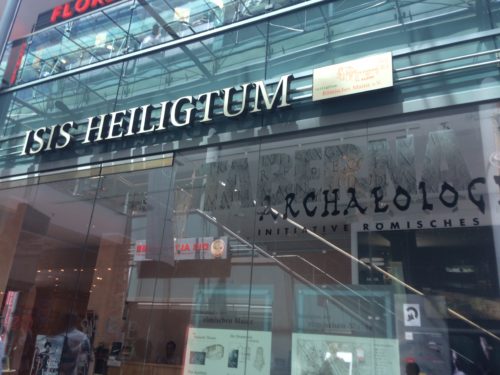
Entrance to the Isis temple in Mainz. [Photo Credit: A. Valkyrie.]
The volunteer at the desk handed me a tour guide in English, and my friend was kind and patient enough to translate everything on the panels inside the museum, which were all in German. What I learned over the next hour from my tour guide and my friend’s translation was the following, retold to the best of my memory with the assistance of a few notes:
Archaeologists and historians knew that a temple to both Isis and Magna Mater had existed at one point in Mainz, but they didn’t know where until the discovery and to this day they still don’t know why it was built. According to historians, a temple like this was usually built after some sort of political catastrophe and/or misdeed on the part of the Roman Empire as a way to both appease the local community as well as appease and ask forgiveness of the Gods. And given the size and the detail of this specific temple, it is assumed that there was some sort of significant event that the Emperor and Senators of the Roman Empire felt a great need to rectify.
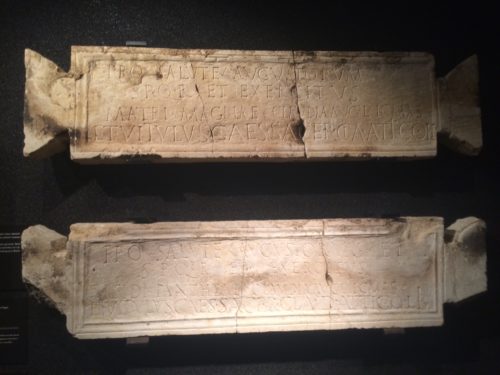
Tablets inscribed to Isis Panthea and Magna Mater. [Photo Credit: A.Valkyrie.]
For the welfare of the emperor (and) of the Roman senate and the people and the army, Claudia Icmas, freedwoman of the emperor, and Vitulus, slave of the prince, under the priest Claudius Atticus, also a freedman, have had this inscription set down for Mater Magna.
Another tablet bears the identical words except that they were set down for Isis Panthea. The naming of these various persons and institutions is suggestive of a very grave or controversial occasion or event that the consecrations were meant to make amends for. There are also a significant number of stamps from various Roman legions on the outer walls of the temple, signifying that not only did the legions feel the need to specifically mark their participation in the building of the structure, but that the structure itself was a state-sponsored and state-financed project.
And yet the specific event or catastrophe that prompted the building and consecration of such a temple is missing from the historical record.
The temple itself was built in several phases, starting in the latter half of the first century, AD, and the cults of Isis and Magna Mater worshiped at the temple for approximately two-hundred years. It had gone through various renovations over that time, with differing materials and architectural styles found throughout the layers. When parts of the temple were demolished and restructured, the building materials from the destroyed parts were re-used in the rebuilding.

Remains of the temple in the center of the museum. [Photo Credit: Matthias Süßen / Wikimedia]
Discovered among the ruins were many poppet dolls and curse tablets, some of which were very detailed in their targets and their aims. The curses ranged from requests for revenge on jilted lovers to pleas for justice in legal matters. The tablets were made of lead, and were rolled up and buried once inscribed. The archaeologists discovered many of these tablets in various stages of decay, which had to be carefully unrolled in order to decipher and translate what was written on them.
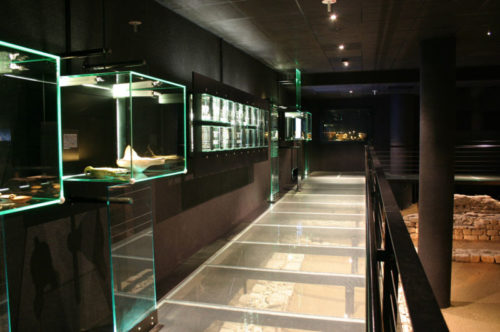
Devotional objects and curse tablets on display. [Photo Credit: Martin Bahmann / Wikimedia]
Remains from the Celtic burial ground that existed in that space prior to the building of the temple were also on display. A burial chamber built of wood planks, which was originally set between an earthen mound, was uncovered and inside the bones of what is believed to be a noble woman were discovered. Her remains were dated through a dendrochronological analysis and were thought to be from around 650 BC. Found buried with the remains were fragments of pottery and jewelry, ostensibly her personal possessions.
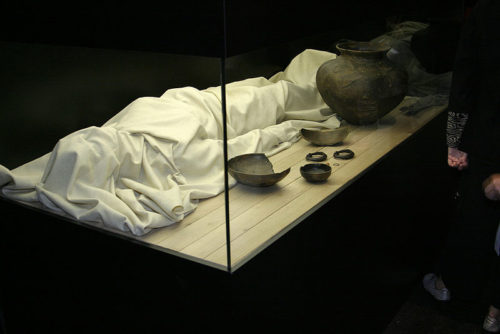
Reconstructed scene and remains from the Celtic burial chamber. [Photo Credit: Martin Bahmann / Wikimedia]
* * *
With my head full of a wide assortment of new knowledge and thoughts and ideas, I bade farewell to my friend, thanked her for her hospitality and her tireless translation throughout our visit to the museum, and then boarded the train to Cologne.
Once I was on the train, I sat and relaxed for a few moments and remembered the dream that I had the night before. I suddenly realized its significance in terms of what I had just learned and witnessed. Aside from the general theme of ancient and sacred places, the Celtic burial chamber that was unearthed below the temple had originally been built below a burial mound, a mound which was constructed for the same purpose and around the same time as the burial mounds in my dreams.
The burial mounds scattered in and around the Ohio Valley and West Virginia were built in the time of the Adena culture, which is estimated to have thrived between 1000 and 200 BC. But unlike the varied historical protection laws that European countries have enacted concerning archaeological remains, Ohio has never enacted a law that protects structures or finds of historical significance despite years worth of pressure on the state legislature to do so.
As a result, countless burial mounds have been destroyed over time, especially over the past century.
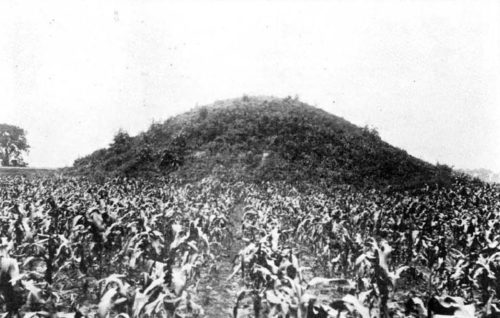
Adena Mound, circa 1900, prior to destruction. [Public Domain]
The land then sat for nearly two decades until last year when developers wanted to build a mall. The developers claimed that they were not aware that the parcel was a recently bulldozed sacred site. Under pressure from the community, they consented to allow archaeologists to dig for thirteen weeks.
And over the course of that time, many archaeological finds were uncovered from bones and teeth to shards of pottery. A local archaeologist estimated that the mound dated from between 200BC to 200AD, putting it in the same general time frame as the remains unearthed in Mainz.
But unlike the temple in Mainz, nobody built a museum in the basement of the new shopping center, which was built on top of the sacred site. What stood before in that spot has not been properly respected or honored or protected. What was once a burial mound is now a Dick’s Sporting Goods, with nothing to remind those who shop there that the building stands on sacred ground.
While the trip to the Isis temple was a breathtaking example of the importance of preserving and restoring historic remains, it was also a stark reminder of how little my own country has progressed in showing such respect or care for the sacred remains that are scattered throughout this land.
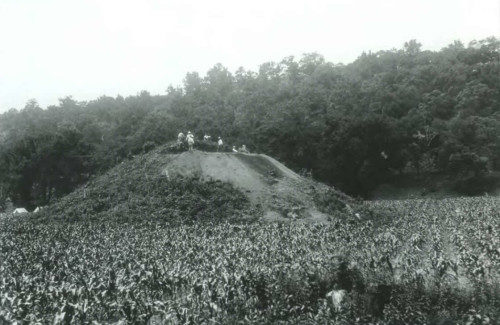
Early stages of the destruction of the mound, 1901. [Public Domain]
This column was made possible by the generous underwriting donation from Hecate Demeter, writer, ecofeminist, witch and Priestess of the Great Mother Earth.
* * *
The views and opinions expressed by our diverse panel of columnists and guest writers represent the many diverging perspectives held within the global Pagan, Heathen and polytheist communities, but do not necessarily reflect the views of The Wild Hunt Inc. or its management.
The Wild Hunt is not responsible for links to external content.
To join a conversation on this post:
Visit our The Wild Hunt subreddit! Point your favorite browser to https://www.reddit.com/r/The_Wild_Hunt_News/, then click “JOIN”. Make sure to click the bell, too, to be notified of new articles posted to our subreddit.

Fascinating article!!! What a wonderful compromise of modern and ancient sites. However, the pictures are incredibly small. Is there a site with better pics of the temple? Thanks for sharing!
Thank you! A few of the pictures I posted came from here:
https://commons.wikimedia.org/wiki/The_sanctuary_of_Isis_and_Mater_Magna,_Mainz
“I admit that I didn’t know much about either Isis or Cybele other than what is contained in the standard myths that most Pagans are familiar with. I had no idea, for example, that Isis was adopted into the Roman pantheon and that her cult thrived there. I had known that the cult of Cybele had reached Rome, but I didn’t know that temples dedicated to her were ever built within the Roman Empire.”
This is the problem with modern Pagans. They do not do research and just read and believe what some pop writer has written about the gods.
I congratulate the author on getting a deeper understanding of what is, in essence, the heritage of all humans.
We have research published at http://www.gallae.com for those interested in learning more about Cybele, the Goddess avatar most suppressed by the Roman church and most feared by them. The first modern Temple to Cybele is in Palenville, NY the home of the Cybeline Revival and the modern Maetreum of Cybele. It is located about ten miles due north of Woodstock.
Thanks, Alley. This is a fascinating account and a call to action.
Temples to Cybele were common all over the Roman Empire as Cybele was attributed with having saved Rome from the second Punic war….. and the worship of Cybele was actually the only senate affirmed “official” religion of Rome for almost 500 years. Temples to both Isis and Cybele were common all over north Africa.
Our modern reclaiming of the Cybeline religion started at the Serpent Mound in Ohio btw.
Great story! I agree that we need to do more here in the US to prevent destruction to historical sites. Every time I think they are making progress in this respect, something happens that completely dismantles that hope.
All this to build something that likely won’t last more than a decade or two.